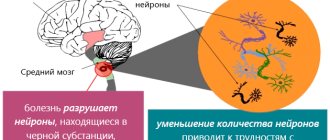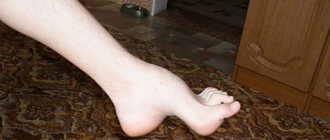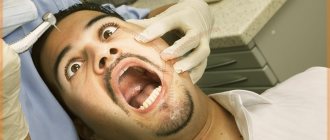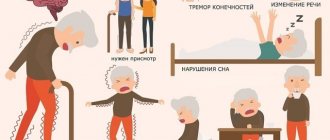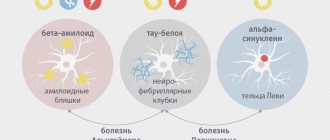Symptoms
The main symptom of sciatica is severe pain, which is initially localized in the lumbar and sacral region, and as the disease progresses, it spreads along one, or less often, both lower extremities. The pain can be burning or dull, continuous or “shooting”, periodically occur in the form of attacks or be present all the time with variable intensity. The pain intensifies with movements of the spine, and in some cases, even a slight movement of the affected limb leads to a severe outbreak of pain.
In some patients, the pain is moderate, but tingling or numbness is felt in the limb or a certain area thereof. Some time after the onset of sciatica, individual muscle groups gradually weaken, which is why the patient has difficulty walking. In the most severe cases, nerve entrapment leads to problems with urination and defecation due to paralysis of the sphincter.
Are you experiencing symptoms of sciatica?
Only a doctor can accurately diagnose the disease. Don't delay your consultation - call
Treatment of meniscus injuries and osteopathy
Treatment of knee meniscus can be conservative or surgical. Currently, arthroscopic operations are widely used, which are performed without large incisions, using special endoscopic equipment. Arthroscopy allows you to examine the joint cavity from the inside, assess the extent of damage, and perform suturing of the tear or removal of part of the meniscus in case of complex injuries. However, these operations are performed only if there are serious indications, while most minor and moderate meniscus injuries are treated conservatively and (alas) not always successfully.
At our center, we use osteopathic methods for treating knee meniscus injuries. We employ osteopathic doctors who have been trained in traumatology and orthopedics and have experience in this field. With the help of osteopathic techniques, recovery from a meniscus injury can be significantly accelerated without resorting to surgical treatment.
In the case of chronic injury (meniscopathy), you almost always need to look for its causes in a violation of the biomechanics of the lower extremities. The menisci may be affected by incorrect body posture, different leg lengths (even within 1 cm), pelvic and sacral misalignment, flat-valgus deformity of the feet and other dysfunctions of the lower extremities. After these violations are eliminated by an osteopath, the trauma to the meniscus decreases and the patient recovers.
In case of acute injuries of the meniscus, osteopathy helps prevent secondary disorders of the biomechanics of the legs associated with prolonged forced hypomobility and altered movement patterns. This gives our patients the opportunity to recover from injury as quickly as possible and return to their previous activities without loss.
Causes of the disease
All diseases and conditions that cause sciatica are divided into two groups:
- vertebrogenic, i.e. associated with injuries and diseases of the spine - this includes osteochondrosis, injuries and deformations of the vertebrae or intervertebral discs, spondylosis, stenosis of the lumbosacral region;
- non-vertebral, i.e. not associated with the spine, are infectious inflammation of the genitourinary system or muscle tissue, hypothermia, excessive physical exertion on the muscular corset of the lower back and pelvic region, a sedentary lifestyle, excess weight, pregnancy, tumor development, etc.
Any compression of the sciatic nerve leads to the development of the disease. The most common cause is a herniated intervertebral disc, a ring of fibrous tissue that separates the vertebrae.
What to do for severe pain in the knee of various types
Painful sensations in the knee can vary in nature and duration among people. They can be constantly aching or develop only under certain loads, at night, etc. For example, some pathological processes are characterized by pain in the knee when bending, others - pain in the knee when walking, etc. Only a specialist can figure out what exactly hurts and why, and how to help the patient.
Knee pain due to coronavirus and other viral diseases
Viral infections can cause joint inflammation. As a rule, these diseases develop against the background of an existing infection and pass without any consequences after its completion. Thus, with influenza and other acute respiratory viral infections with acute fever, both short-term joint and muscle pain and acute arthritis with inflammation and swelling of the knee joints may appear. Their course is favorable.
Coronavirus infection has its own characteristics: it occurs differently in each patient. Why this happens is unknown. During the disease, aching joint pain, swelling and redness sometimes appear - a sign of acute arthritis, but then they go away.
Arthritis, which begins approximately a month after coronavirus infection, is more dangerous. The fact is that it has a significant effect on the immune system. Malfunctions of the immune system lead to the development of autoimmune processes. This is especially dangerous for people who have close relatives suffering from chronic arthritis. Experts note a high risk of developing rheumatoid arthritis (RA) in such patients. The first sign of RA is stiffness of movement in the morning (difficulty bending the knee).
If arthritis appears after recovery from a viral infection, you should immediately contact a rheumatologist.
Severe pain under the knee
This may be a sign of the development of a Baker's cyst - a distended synovial bursa with fluid located in the popliteal area. The cyst and associated pain under the knee appear due to the fact that it is connected to the cavity of the knee joint and is filled with synovial fluid. In this case, the reverse flow of liquid is difficult for various reasons. Most often, the cyst develops against the background of bruises, arthrosis and arthritis of the knee.
A small cyst can go unnoticed for years. But with its significant size, the surrounding tissues begin to be compressed, causing pain under the knee, which intensifies with physical activity, including walking and running. Women get sick more often. Sometimes the cyst disappears on its own, but often it progresses and increases in volume, which can lead to rupture or suppuration.
If you have pain under your knee, it is better to consult a doctor as soon as possible. Conservative (removal of fluid from the cyst, injection of glucocorticoids into it) and surgical (removal of the cyst) treatment is carried out.
Severe pain in the left or right knee
Severe pain in combination with swelling and redness of the skin over the right or left knee usually indicates the development of an acute inflammatory process. This can be acute nonspecific arthritis (the process can turn purulent), reactive arthritis, which begins a few days after a urogenital or intestinal infection. Both diseases occur with similar symptoms; a correct diagnosis can only be established after a full examination.
The right or left knee can suffer from microtraumas, for example, in athletes or workers in certain professions who use one (usually the right) knee more.
It is important at an early stage not to use folk remedies, but to carry out the correct treatment, this will allow you to fully recover and forget about the pain forever. But even with advanced diseases, a specialist will always be able to provide assistance and relieve pain.
Crunching in joints - when to worry
Joint pain at rest
Knee and leg pain
Depending on the cause of the disease, its course and the presence of complications, severe knee pain may include:
- in the lower leg below the knee
- they are rare, this may indicate compression of the nerve branches innervating the muscles of the lower leg by the inflamed, swollen periarticular tissues in the knee area; pain under the knee in the back indicates compression of the branches of the sciatic nerve, and pain under the knee in the front indicates that the nerves innervating the anterior surface of the leg are affected; Such diseases are treated by a rheumatologist, but consultation with a neurologist is required; - above the knee, into the thigh
- often a sign of post-traumatic inflammatory process in the femoral-patellar joint; in this case, patellofemoral pain syndrome develops; the pain is strong, aching, sometimes twitching, aggravated by walking; an orthopedist-traumatologist and a rheumatologist will help you cope with pain; - on the side, on the inside
– pain can develop with injury and damage to the internal lateral articular ligament; pain on the side is strong, jerking, with hemarthrosis (intra-articular hemorrhage) - bursting, accompanied by imbalance of the joint, the whole leg crunches when moving; the same pain appears when the external collateral ligament is sprained; assistance will be provided by an orthopedist-traumatologist.
To eliminate pain, you need to accurately determine its cause, and this is impossible to do on your own. Need doctor's help.
Patella pain on the back, front and sides
Pain in the patella is almost always the result of acute or chronic injuries:
- pain behind the knee
- the causes are associated with damage to the femoral-patellar joint with the development of patellofemoral pain syndrome; the pain is aching, constant, aggravated by walking; - in the front
- such painful sensations are caused by superficial bruises of the knee or frequent prolonged stay on the knees with microtrauma to the kneecap; the pain is significant, as the periosteum, rich in nerve endings, is injured; - pain in the knee on the side -
when the horizontal internal or external patellar ligaments are ruptured or injured; injury can develop with frequent long-term microtrauma of the ligaments, for example, during jumping; accompanied by bleeding into the joint cavity (hemarthrosis); pain is strong, constant, accompanied by swelling; movements in the leg are impaired.
To prevent permanent dysfunction of the joint from developing at the site of injury, you should immediately seek help from an orthopedic traumatologist.
Knee pain radiating to the leg, heel, groin
Knee pain can radiate to the leg, groin, or back
The causes of radiating acute pain in the knee need to be understood. The reason may be:
- femoral nerve entrapment; the pain is acute, piercing in nature, begins sharply in the groin area, spreads along the anterior-inner surface of the thigh and knee, along nerve branches it can reach the inner edge of the foot and heel; sometimes the patient gets the impression that the knee hurts, but this is not the case;
- arthritis (gonarthritis) of various origins: swelling of the joint leads to pinched nerves and the spread of sharp pain in the knees up to the groin and down to the heel; in this case, a mainly aching pain is felt in the knee, which with sudden movements turns into acute pain with irradiation above and below the knee;
- bruise accompanied by hemarthrosis, ligament rupture, severe swelling and compression of nerves;
- bruise with a fracture or dislocation of the patella and imbalance of the joint; acute pain in the knee extends down the thigh to the groin, along the inner surface of the shin - lower, to the heel.
Severe knee pain of this nature requires immediate medical attention. No folk remedies will help, you need to call an ambulance.
Knee pain during extension and flexion
Most often, pain in the knee during flexion and extension, as well as when squatting, is a sign of tendonitis - an inflammatory process in the area of the tendon-ligamentous apparatus of the knee joint. It develops mainly in young men involved in sports and is a consequence of frequent repeated microtraumas associated with jumping and constant shaking of the limb. The first sign is the inability to straighten the knee painlessly.
The cause of painful flexion and extension of the knee can also be arthrosis - degenerative-dystrophic changes in the joint with the growth of connective and bone tissue that interferes with movement.
Only treatment of tendinitis or arthrosis helps relieve the patient from severe pain in the knee when flexing and extending.
Severe knee pain at night
Night pain is characteristic of inflammatory processes. This may be latent arthritis, periodically inflamed knee joint due to arthrosis (arthrosis-arthritis). During sleep, joint and periarticular tissues warm up, blood vessels dilate, which increases swelling.
The periarticular tissues swell, compress the nerve endings, and pain develops. If at the same time there is pain behind the knee, then this may be a sign of a Baker's cyst. How to get rid of swelling and night pain? Treatment of the underlying disease helps.
Knee pain when walking
Pain when moving, jogging, nagging pain under the knee are characteristic of degenerative-dystrophic processes in the knee - arthrosis, since during movement the articular surfaces are injured, completely or partially devoid of shock absorber cartilage. The periosteum, which has good innervation, suffers. Knee pain when descending stairs is also very common. After exercise, patients note that the pain in the knee continues to ache for some time. Over time, pain appears in the foot.
Long-term rehabilitation treatment with the use of chondroprotectors - medications that restore cartilage tissue - will help. In case of complete destruction of the joint - endoprosthetics.
Pain after exercise - squats, running, weight lifting
This indicates long-term microtrauma of the knee joints and the gradual formation of degenerative-dystrophic processes in them. Sometimes pain appears in one right or left knee. Joints crunch.
If there is severe pain in the knee after training, then the athlete needs rehabilitation treatment. Otherwise, there will be a gradual decrease in joint function, accompanied first by periodic and then constant pain.
Knee pain and crunching
Sharp, sudden pain in the knee and crunching (crackling) indicates a rupture of the meniscus - the cartilaginous shock-absorbing pads in the knee joint. This may be the result of injury or age-related wear and tear of the cartilage structures.
Severe joint pain may go away, but pain in the knee will remain when squatting, then dysfunction of the limb will gradually increase, accompanied first by pain during exercise, and then by constant pain, which intensifies when going down the stairs. Over time, the entire limb suffers and crunches, including the foot. Long-term rehabilitation treatment under the supervision of an orthopedist-traumatologist helps.
Knee pain and swelling
Pain accompanied by swelling always indicates the presence of an inflammatory process. It can be aseptic (without the presence of infection, usually after injury), infectious, infectious-allergic and autoimmune (with an allergy to one’s own tissues).
To get rid of such pain, you need to identify their cause and carry out treatment prescribed by a specialist.
Diagnostics
The primary diagnosis of sciatica begins with an examination by a neurologist, who, during a conversation, clarifies the nature and location of the pain, its frequency and duration. The doctor will then check for some sciatica symptoms:
- asks the patient to bend and straighten his leg - pain should appear in the popliteal fossa;
- asks to bend the straight leg at the hip joint, and then at the knee - pain in the lower back and hip first appears, then disappears.
To clarify the prevalence of the inflammatory process, instrumental diagnostic methods are used:
- X-ray of the lumbar region to check for the presence of spondylosis and filter out a number of other diseases as the cause of pain;
- Ultrasound to detect inflammation, injury or tumor in soft tissues;
- MRI, which allows you to detect abnormalities in the bone structure and soft tissues;
- electroneuromyography to check the condition of nerve fibers (prescribed for sensitivity disorders).
In many patients, at the beginning of the disease, the pain is not too severe and is short-term, so people are in no hurry to seek medical help. However, the signals that your body gives should in no case be neglected, because the earlier treatment is started, the less complex and lengthy it will be.
Symptoms of knee meniscus damage
Due to the complex structure of the knee joint, it can be quite difficult to distinguish injuries to the menisci from injuries to other structures. A correctly collected anamnesis and medical history is very important for successful diagnosis.
In the acute period of injury, the symptoms of meniscus damage are nonspecific, that is, they cannot be clearly differentiated from ligament damage, for example. The patient is worried about severe pain, swelling of the knee, and the inability to straighten the leg. 2 - 3 weeks after the injury, meniscus damage can be differentiated using special tests (mediolateral test, Shteiman-Bragard symptom, Baikov, etc.). Movements in the joint are blocked, there is severe pain and infiltration along the joint space.
With damage to the external meniscus, joint blockade is less common, since this meniscus is more often subject to compression due to its mobility. Sound tests, in which clicks are heard during passive movements of the joint, are of great importance for diagnosing meniscus injuries.
With frequent minor injuries to the knee, meniscopathy can develop - a condition when the meniscus is deformed, subjected to compression, and micro-tears appear in it. With prolonged chronic injury, degeneration of the meniscus, its cystic degeneration, and constant pain develop.
MRI and arthroscopy provide some assistance in diagnosing knee meniscus injuries. An internal examination of the joint may reveal thinning of the meniscus, tears, fiber separation, etc. X-rays do not provide sufficient information for meniscus injuries.
Therapy
The greatest discomfort for the patient, as a rule, is caused by a pain symptom, and treatment of sciatica is aimed not only at eliminating the cause that caused its occurrence, but also at relieving pain. For this, the neurologist prescribes:
- non-steroidal anti-inflammatory drugs that relieve inflammation and reduce pain;
- antispasmodics and muscle relaxants to eliminate muscle spasms leading to compression of nerve tissue;
- analgesics to reduce pain;
- glucocorticosteroids to reduce inflammation and relieve pain;
- vitamins to strengthen the function of nerve fibers and improve the conduction of nerve impulses.
In addition to drug treatment, physiotherapeutic procedures for sciatica have a positive effect on health:
- electrophoresis - the effect of a weak electric current and a drug on the skin in the area of inflammation;
- UHF – exposure to weak currents of ultrasonic frequency, which has a warming and stimulating effect;
- laser beam therapy, which has a stimulating and analgesic effect;
- magnetic therapy to relieve pain in the affected area, reduce tissue swelling, and relieve inflammation;
- massotherapy;
- manual therapy;
- acupuncture (acupuncture).
Patients with acute pain require bed rest to avoid further irritation of nerve fibers and increased inflammation.
During the period of remission, special physical exercises are of great benefit; for sciatica, they are prescribed to stimulate metabolic processes in weakened muscles, improve blood circulation and strengthen muscle tissue.
Surgical intervention to treat sciatica is used in extremely rare cases:
- upon detection of a benign or operable malignant tumor;
- if severe pain does not decrease after one and a half months of active therapy;
- with serious dysfunction of the pelvic organs.
If you consult a doctor in a timely manner, the prognosis is usually favorable, and the patient will be free from pain for a long time or completely.

